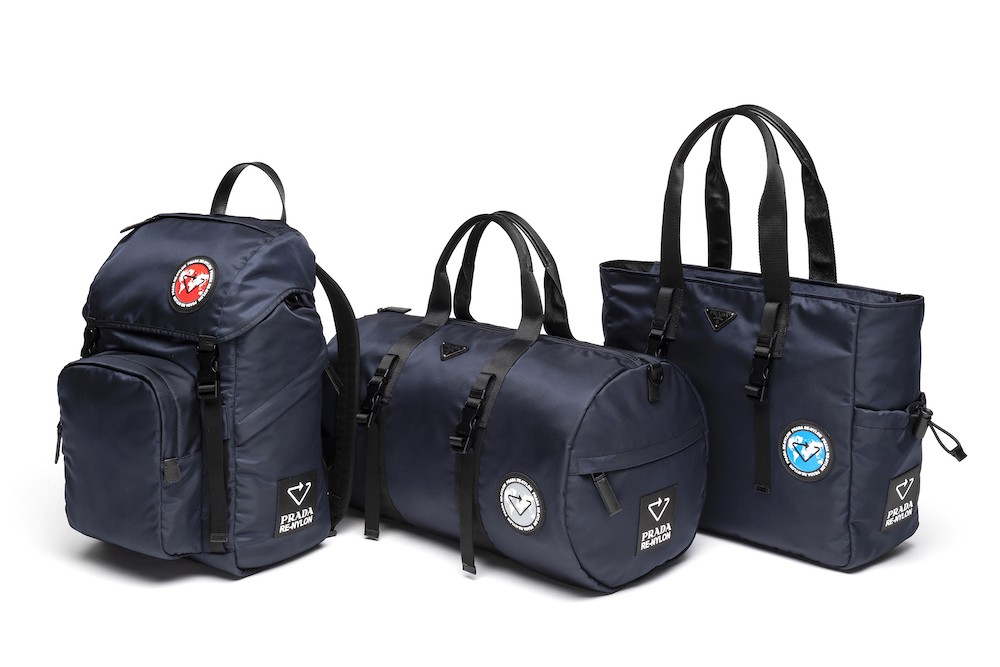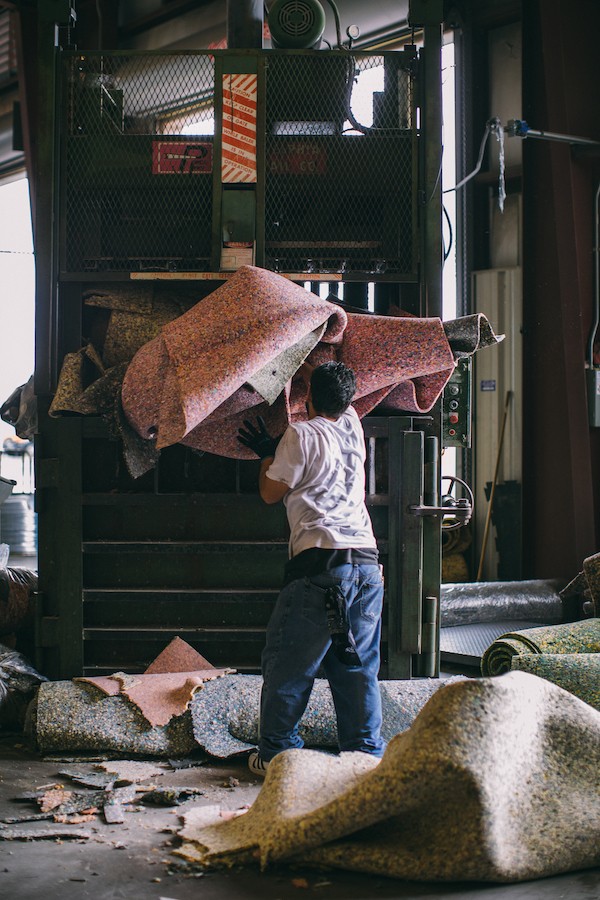
In June, Prada announced that they would be switching from virgin nylon to using Econyl: regenerated nylon that is created after the recycling and purification of plastic waste. The Italian brand also launched a line of sustainable bags to cement their goal of completely cutting out virgin nylon by the end of 2021.
“I’m very excited to announce the launch of the Prada Re-Nylon collection. Our ultimate goal will be to convert all Prada virgin nylon into Re-Nylon by the end of 2021,” said Lorenzo Bertelli, Prada Group’s Head of Marketing and Communication. “This project highlights our continued efforts towards promoting a responsible business. This collection will allow us to make our contribution and create products without using new resources”. According to Prada, “For every 10,000 tons of Econyl created, 70,000 barrels of petroleum are saved. This reduces environmental emissions of CO2 by 57,100 tons. By choosing to use Econyl, the impact of petroleum-fuelled nylon-production on global warming will be reduced by 80%”.
Their Re-Nylon Capsule Collection includes six different styles for men and women: a belt bag, shoulder bag, tote bag, duffle and two Prada backpacks. They are all produced with environmentally- friendly materials and feature a triangular Prada logo, a nod to the universally recognisable recycling symbol. For the fashion house, “(the new logo) emphasises a bucking of the traditional, age-old linear supply chain into a cyclical one, focused on renewal”.

The project partners Prada with Aquafill, the parent company behind Econyl. The Italian textile yarn producer founded Econyl in 2011. With the first plant in Ljubljana, Slovenia, Econyl uses pre- and post- consumer waste to produce regenerated nylon yarn. The waste includes carpet, offcuts from the fashion industry and old fishing nets. “With this project Prada marks the step, taking on a leading role in environmental sustainability among Italian brands. “We are happy to collaborate on their capsule collection, but above all, to support them as partners in the process of converting the entire nylon production,” said Aquafil Chairman Giulio Bonazzi.
Econyl has reportedly also been supplying to household name brands, like Adidas and H&M, along with others such as Stella McCartney, Mara Hoffman and Fisch- who have sustainable fashion at the forefront of their work. And with other fashion houses, like Burberry and Gucci, also making their own changes to what type of fabrics and materials they use, Prada is joining an increasing number of fashion brands that wish to combat fashion waste. However, according to the Econyl plant manager in Phoenix, Arizona, Juan Carlos Anota, many brands prefer up-cycling fishing nets due to their role in marine pollution. Despite 1.3 million tons of carpet also being shipped to landfills every year, they are not really one of the materials that brands gravitate towards. Prada, on the other hand, is also using the recycled carpet that Econyl’s European plants produce.
The exact science behind the process sounds complicated, but Prada explains that “Econyl yarn is made of recycling discarded plastic that has been collected from landfill sites and oceans across the whole planet.The production process (consists of) gathering of waste materials: fishing nets, discarded nylon, carpet and industrial waste are sorted and cleaned to maximise the quantity of recuperated nylon; regeneration and purification: through a chemical de-polymerisation procedure, the nylon waste is recycled right back to its original purity; (and finally) at production plants in Ljubljana, Slovenia and Arco, Italy, the recycled materials is re-transformed into polymers and threads through a new polymerisation process”.

Prada’s Re-Nylon campaign, which comes a few weeks after they announced that they would no longer be using real fur in their products, focuses not just on using sustainable, up-cycled nylon but also on creating a more lasting impact. An undisclosed percentage of sales generated from the new collection will be donated to an un-named environmental sustainability project. Prada is also partnering with UNESCO to develop educational activities for students from all over the world to spread awareness about plastic and the circular economy, two things that are at the heart of the campaign.
For the company, “Prada Re-Nylon reinvents the idea of timeless, as something that can truly last forever”.
National geographic, Prada’s Storytelling partner, has also begun releasing episodes for a short series titled What We Carry that will focus on documenting the process behind the massive shift for the Milan based brand. The first of the five episodes was released on the 24th of June 2019 and follows activist and actress Bonnie Wright (best known for her portrayal of Ginnie Wesley in the Harry Potter franchise) and National Geographic explorer Asher Jay as they travel to Phoenix, Arizona. They visit the Econyl processing plant there that up-cycles carpets and turns them into re-usable nylon fibres and wool. The rest of the four episodes will follow Wright and Jay to Ljubljana, Slovenia (home to Econyl’s Julon plant); Lake Ossa, Cameroon; Ganzhou, China and Wellington in New Zealand.
It appears that both 2020 and 2021 will be extremely busy years for Prada as the company has now started to focus more than ever on the environmental pillar of the triple bottom line. With an increase in their younger consumer base of people who are concerned about environmental sustainability (due to rise of relatively unsustainable fast fashion and recent Climate Change strikes) it appears that Prada and other fashion companies now have to cater to their desire to buy environmentally friendly products.
According to the World Bank, the fashion industry consumes 79 billion cubic meters of water per year- a highly unsustainable amount. In a recent report by the Environmental Audit Committee of the UK, it was found that the textile industry contributes more to environmental pollution than “international aviation and shipping combined”. They estimate that, at least in the UK, “Less than 1% of material used to produce clothing is recycled into new clothing at the end of its life”. Released in February 2019, the report calls for fashion brands to shift from using virgin polyester to recycled PET or polyethylene terephthalate which is most commonly used in the making of fibres. Most brands, like Prada and Gucci, however, prefer up-cycling nylon instead.
According to reports by National Geographic, the main reason why brands prefer up-cycling nylon (from carpets and other products) as opposed to other harmful materials like polyester, is because polyester is more expensive to recycle as opposed to using the virgin material. While recycling polyester would be a financial liability to carpet mills, nylon can be repurposed and recycled “ad infinitum – presenting the prospect of a cradle to cradle production cycle where old carpets are turned into new ones over and over again”- an idea that goes back to the timelessness and circular economy of Prada’s campaign.
“All products have stories. How they are made affects lives and affects the planet,” that’s how Wright’s disembodied voice ended the first episode of What We Carry. And it appears that has become Prada’s new motto for the foreseeable future.





